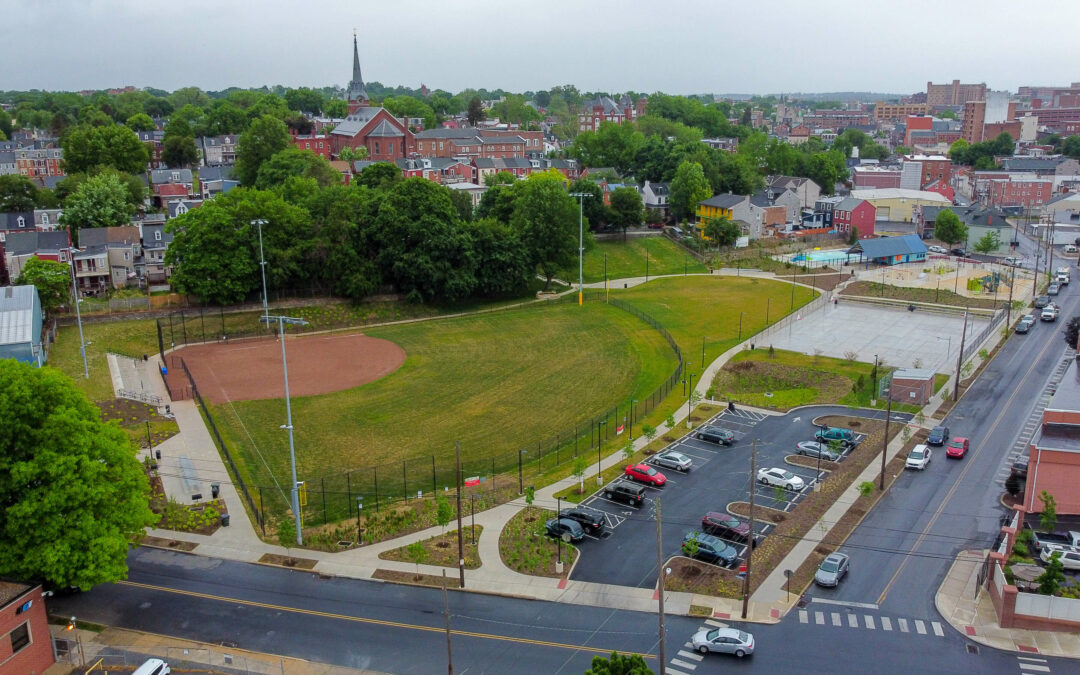In addition to their roles as accessible public spaces, restored parks can emerge as dynamic hubs that positively impact physical and mental wellness, social cohesion, environmental sustainability, and cultural identity within a community. Flyway Excavating has been honored to support the development and restoration process of many local parks including Culliton Park, Long’s Park, and Ewell Plaza in Lancaster City. Read on to discover more about how park restoration fosters community and environmental flourishing.
Community Benefits
Physical and Mental Health
Enhanced open spaces within restored parks provide the ideal environment for athletics and outdoor play. Alongside the many health benefits of physical exercise, these revitalized recreational areas also foster social interactions and engagement, which positively impact mental health and well-being. This harmonious blend of nature access, enhanced recreation, and community connection creates a vibrant environment that promotes holistic health for individuals and for the community.
Social Cohesion and Community Building
Often strategically designed with community engagement in mind, restored parks bring people together and create opportunities for shared experiences. By facilitating events and activities and promoting a sense of affiliation, ownership, and pride among residents, restored parks play a crucial role in fostering connections and strengthening social bonds within a community.
Aesthetic and Cultural Value
Restored parks serve as captivating communal gathering points. Public art installations, open-air performances, and cultural events all find a natural home within restored parks. Many parks also harbor historical significance, whether through architectural elements, commemorative structures, or as sites of cultural or historical events. Whether it’s a centuries-old tree, a historic fountain, or a profound sculpture, these elements become important components of a restored park’s narrative, connecting past, present, and future.
Environmental Benefits
Biodiversity Conservation
Restored parks can play a pivotal role in safeguarding and enhancing the local ecosystem. In the park restoration process, native plant and animal habitats are preserved and revitalized, boosting biodiversity conservation. The restoration process may also involve the introduction of new plant species, including those with ecological value, such as pollinator-friendly flowers, which not only enhance visual appeal but also foster a more robust and interconnected ecosystem. This, in turn, attracts a diverse array of wildlife, creating a balanced and self-sustaining biodiverse environment.
Air and Water Quality Enhancement
Park restoration can also contribute to air and water quality improvements. New trees and vegetation within restored parks absorb and neutralize airborne pollutants, including particulate matter, nitrogen dioxide, and volatile organic compounds. This not only enhances the immediate air quality within the park, but also has a positive spillover effect, influencing the overall air quality of the surrounding area.
Regarding improved water quality, water features such as ponds and wetlands enhance visual appeal and serve as natural water purification systems, filtering contaminants and improving overall water quality. Additionally, the complex root systems of vegetation within parks act as natural barriers, anchoring the soil, preventing soil erosion, reducing water runoff, and thus contributing to improved water quality.
Green Infrastructure
Green infrastructure provides holistic and sustainable solutions to address environmental challenges. When it comes to park restoration, green infrastructure offers many environmental, social, and economic benefits. Typically, green infrastructure within restored parks leverages natural elements within the landscape alongside the implementation of manufactured components. Together, these elements enhance infiltration, support biodiversity, reduce stormwater runoff and flooding, and also contribute to improved air and water quality.
We have experience installing and implementing various types of green infrastructure across a variety of projects, including:
- Stormwater basins
- Rain gardens
- Permeable pavers
- Permeable blacktop
- Subsurface detention systems
- Cisterns
- Bioswales
At Flyway Excavating, we are passionate about helping our clients build green infrastructure to benefit the community and protect the environment.
Want to partner on a park restoration or construction project? Contact us today.
